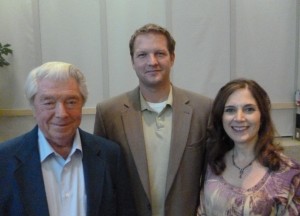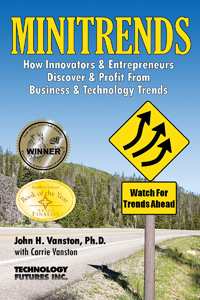Focusing On Competencies for Degree Programs
March 1, 2012

Dr. John Vanston, TFI & Author., MINITRENDS, Michael Bettersworth, TSTC, and Carrie Vanston, TFI & Co-Author, MINITRENDS at Austin Innovators and Entreprenuers Series sponsored by IBM/Austin Chamber of Commerce
Last week at the Austin Innovators and Entrepreneurs Series sponsored by IBM Venture Capital Group, IBM Innovation Center, and the Austin Chamber of Commerce, I had the pleasure of speaking with Michael Bettersworth about what he saw as emerging Minitrends in education. Michael is the associate vice chancellor for technology advancement at Texas State Technical College (TSTC) and director of TSTC Forecasting. TSTC Forecasting identifies new competencies needed by employers so that college curriculum can be updated to increase the employability of college graduates and provide a highly skilled workforce for Texas employers. Since my company, Technology Futures, Inc. (TFI), worked with Michael and TSTC developing the TSTC Forecasting program in 2002 and conducted several technology forecasts for them in the proceeding years (see below for access to electronic versions of those forecasts), I was particularly interested in what he had to say.
According to Michael, “When we began forecasting emerging employer demand we focused primarily at the job and degree plan level. Today we focus on the alignment of competencies across jobs and curriculum. In other words, we have to look for the Minitrends. For example, mobile application development is now an established part of the IT sector. The Minitrend within mobile apps is the need for new competencies such as html5 and Java for structuring and presenting content across mobile devices. Similarly, we don’t need colleges to develop entirely new degree programs for this sector, but rather update curriculum within applicable existing awards or perhaps offer specialized short-term training options for those looking to upskill.”
Michael continues, “A competency-based approach that looks for Minitrends is more efficient and produces more actionable recommendations for college leaders. It’s with this kind of nuanced decision-making that the needs of industries are met and the value of Minitrends can be realized.”
The TSTC Forecasting Program with Michael’s enthusiastic leadership has led to the development of new technology courses, certificates, and degree programs offered at colleges throughout the State of Texas and funding for talent pipeline development through new capacity building and student scholarship grant funds. We appreciate his insight into how to best prepare our workforce for the needs of our future.
___________________
As mentioned above, we at TFI were partners with Michael and TSTC in the development of the TSTC Forecasting program and conducted several technology forecasts for TSTC. The TFI authored or co-authored reports are available in electronic form at no cost to our readers (also for sale on Amazon). (The programs more recent TechBriefs are also available on the TSTC site.)
—Mechatronics, A Technology Forecast, by John H. Vanston, Ph.D., Ph.D., Henry Elliott, M.S.M.E., Jim Brazell, Eliza Evans, Ph.D., James A Irwin, and Michael A. Bettersworth
—Home Technology Integration, A Technology Forecast by John H. Vanston, Ph.D., Henry Elliott, M.S.M.E., Michael A. Bettersworth, MA, and Wayne Caswell
—Emerging Technology Programs for Texas Colleges: Advanced Digital Manufacturing, Hybrid Vehicles, Micro-Electromechanical Systems, and Computer Forensics: Three Emerging Technology Employment Opportunities by John H. Vanston, Ph.D. and Henry Elliott, Program Director: Michael A. Bettersworth
—Homeland Security, A Technology Forecast by John H. Vanston, Ph.D. and Henry Elliott, Program Director: Michael A. Bettersworth
—Fuel Cells, A Technology Forecast by John H. Vanston Ph.D., Henry Elliott, Program Director: Michael A. Bettersworth
—Nanotechnology, A Technology Forecast, by John H. Vanston Ph.D., Henry Elliott, Edited by: Larry Grulick, Ph.D., Michael A. Bettersworth
The TSTC Forecasting program is based on Programs for Emerging Technologies (PET), a process developed by TFI and the Texas State Technical Colleges (TSTC) System for identifying emerging technologies and then forecasting associated technical advances, market developments, and employment opportunities. Many of the concepts involved may be useful to others seeking new growth opportunities.
“Nine Emerging Minitrends to Watch” by Dr. John H. Vanston, MINITRENDS Author & Chairman, TFI
December 28, 2010
 Happy holidays to Minitrends blog readers! We appreciate your interest in our Minitrends posts and activities. As we start the new year, there will be many opportunities for those who are alert enough to recognize emerging trends, perceptive enough to realize their importance, and clever enough to take advantage of them. Here I suggest nine Minitrends—emerging trends that will become significantly important within 2-5 years, but are not yet generally recognized—that are well worth examining for possible action by those ambitious individuals who seek to start new ventures or keep existing businesses innovative and competitive.
Happy holidays to Minitrends blog readers! We appreciate your interest in our Minitrends posts and activities. As we start the new year, there will be many opportunities for those who are alert enough to recognize emerging trends, perceptive enough to realize their importance, and clever enough to take advantage of them. Here I suggest nine Minitrends—emerging trends that will become significantly important within 2-5 years, but are not yet generally recognized—that are well worth examining for possible action by those ambitious individuals who seek to start new ventures or keep existing businesses innovative and competitive.
Unlike megatrends, Minitrends are of a scope and importance to offer attractive opportunities to individual entrepreneurs, decision-makers in small and mid-size businesses, innovative thinkers in large companies, and adventuresome investors. In my new book, MINITRENDS: How Innovators & Entrepreneurs & Discover & Profit From Business & Technology Trends, I categorize the nine Minitrends below to those most applicable to different-sized groups. (In the book, I also discuss the background, current trends, and business opportunities of each of these Minitrends in more depth.) I do the same categorization below, but in reality, all provide opportunities to perceptive individuals in all-sized businesses.
Minitrends Particularly Applicable to Individuals or Small Groups of Individuals:
1. Expanding Involvement in Virtual Worlds (Free Virtual Worlds book excerpt available):
Virtual worlds are computer-based platforms that allow participants to engage in a wide range of real-world type activities, e.g., buying and building virtual world property, furnishing virtual world homes and offices, producing and selling virtual world goods, traveling, taking part in virtual world social activities such as parties and fundraisers, and communicating with other participants. Increasingly, virtual worlds are being used for educational purposes, product advertisements, new product modeling and testing, identification of new markets, and uncovering unexpected problems with new marketing programs.
2. Support for People Working at Home:
Although an increasing number of people are now conducting all or part of their work at home, these people often find they miss interacting with others and miss the convenience of facilities, equipment, and administrative support. A number of solutions are emerging to better meet the needs and desires of people working at home, including small offices or meeting rooms that can be rented by the day or the hour; chat rooms where people can meet informally to discuss ideas; semiformal groups that meet regularly to establish person-to-person interactions; and temporary support staffs organized to provide administrative assistance as needed.
3. Expanding Capabilities of Advanced Websites:
Although the World Wide Web had proven to be extremely popular, many believed a more interactive platform that took advantage of the Web’s power to communicate would be desirable (Web 2.0). Programmers are now expanding the capabilities of the Web to substitute computer activities for human activities, particularly activities that are repetitive, burdensome, and uninteresting (Web 3.0). Many believe Web 3.0 will eventually lead to effective artificial intelligence that can interact with humans in natural language.
Minitrends Particularly Applicable to Small and Medium-Size Companies:
4. Increasing Interest in Privacy:
Recent advances in technology, together with an increasing willingness of many to make personal information more easily available are threatening traditional concepts of privacy in terms of messaging, personal profiles, and identity. Techniques for countering these invasions of privacy, such as personal caution, technology aids, and group action are now being developed.
5. New Approaches to Giving and Receiving Advice:
Individuals and organizations commonly seek expert advice when making important decisions. In providing such advice, large consulting firms with large, multidisciplinary staffs, well-structured processes and procedures, huge computer capabilities, and long-standing reputations have traditionally had a major advantage. However, the ever-increasing power and ubiquity of information gathering, processing, and communicating technologies, small and medium-size consulting groups are often able to give more focused, timely, and user-friendly advice than the larger firms.
6. Evolution of Meaningful Maturity:
The twin trends of increasing life spans and decreasing retirement ages have caused a steady increase in retirement years. Because of social, personal interest, and/or financial reasons, many older individuals are either staying in their jobs longer or returning to the workforce. Their ability to utilize their experience, skills, and dedication effectively will depend on their current capabilities, their desires, and open opportunities to those willing to assist them.
Minitrends Particularly Applicable to Large Companies:
7. Advances in Digital Manufacturing:
Advanced digital manufacturing (ADM) processes build complex, custom-made parts by the addition of successive layers of material rather than traditional machining processes that cut, bend, and machine a part from stock material. The processes allow quicker production of prototypes and small production runs at a much lower cost. Recent ADM advances, including improved yield rates, reduced time-to-market, increasing variety of materials, and advances in 3D modeling software, have made ADM processes increasingly attractive to many manufacturers.
8. Increasing Electricity Use in Manufacturing:
The characteristics of electric power, such as high power density, no heat transfer medium requirements, controlled energy distribution, reduced material waste, and less environmental impacts, provide a number of benefits to manufacturing processes. Its use, however, has been limited by its relatively high cost. A number of factors, including advances in control technologies, changing customer needs, global competition, and increasing concern about the environment, are driving an increasing growth in the use of electricity in industrial processes.
9. New Applications of Nanotechnology:
When many substances are reduced to nano-size (100 nanometers or less) they often exhibit very different physical, electrical, chemical, and optical properties from the same substance at macro-size. These new properties often provide very unique and useful characteristics to nano-materials that can be used in a wide range of practical applications, such as cancer treatment, very high strength materials, special electronic systems, and water purification. Improved production techniques, decreased costs, and growing experience and understanding are increasing the practical applications of nanotechnologies
Minitrend involvement can give you a way to separate yourself from your colleagues and contemporaries. It provides a means for materially improving your business situation, your financial standing, and your personal satisfaction. I hope the Minitrends listed above will assist you or inspire you to launch your own exciting, profitable Minitrend Adventure that allows you to utilize your imagination, your logic, your innovative nature, and your basic good sense in the coming year.
Copyright 2011. Please feel free to reprint this article in whole or part with due credit to: “by Dr. John H. Vanston, MINITRENDS Author and Chairman, Technology Futures, Inc.” Thanks!
Trends in Nanotechnology: Killing Cancer with Light
October 5, 2010

On page 133 of MINITRENDS, Dr. John Vanston describes an interesting experiment in killing cancer cells with light therapy:
A very interesting application of nanotechnology in the medical field is a treatment for cancer currently being developed commercially by BioSpectra. This treatment is based on research developed by Rice University and the M.D. Anderson Cancer Research Institute. When reduced to nano-size, the color of gold depends on the size of the particles, e.g., red, blue or green. In this treatment process, gold particles of a size that corresponds to visible light are attached to biological molecules that migrate to the location of the cancer. The patient is then subjected to a beam of light of the matching color. The energy of the light is deposited in the gold particles, raising the temperature, and burning up the cancerous cells. Visible light can penetrate about 15 centimeters (roughly, six inches) into the body without damaging non-cancerous tissue, contrary to current radiation treatments.
Light therapy has a growing number of uses in the medical field. While the increasing use of light in medicine is a “megatrend,” the particular applications that are coming online in the next few years are Minitrends. These include not only using light to kill unwanted cells, but also to detect them.
Anne Trafton, a biologist and science journalist writing in MIT News, reports on the efforts of MIT researcher Geoffrey von Maltzahn and Harvard-MIT researcher Sangeeta Bhatia to use gold nanorods as a cancer detection tool. Trafton explains how the process works:
Gold nanoparticles can absorb different frequencies of light, depending on their shape. Rod-shaped particles, such as those used by von Maltzahn and Bhatia, absorb light at near-infrared frequency; this light heats the rods but passes harmlessly through human tissue.
The nanorods’ homing abilities also make them a promising tool for diagnosing tumors. After the particles are injected, they can be imaged using a technique known as Raman scattering. Any tissue that lights up, other than the liver or spleen, could harbor an invasive tumor.
Last week, Katia Moskvitch, a Canadian science writer working for the BBC, reported on advances in “Raman spectroscopy,” a method for using light in diagnostics. Raman spectroscopy can rapidly analyze the molecular composition of tissue and bone, detecting abnormalities. Moskovitch interviews University of Michigan researcher, Michael Morris, who says:
Raman gives you a molecular fingerprint, a composition of whatever it is you’re measuring. In diseased states, the chemical composition is either slightly abnormal or very markedly abnormal, depending upon the diseases.
The hope is to conduct diagnostics without needle sticks, blood drawing, or incisions. One of the most sought-after applications is a glucose meter for diabetics, with which the patients would only have to shine a light to their skin, rather than having to prick themselves to draw blood. Shirley S. Wang, a clinical psychologist from Yale University, wrote in The Wall Street Journal that researchers at the G.R. Harrison Spectroscopy Lab at MIT hope to have a wearable diabetes monitor within two to five years.
These are some of the many interesting uses of light in medicine that show promise for development in the near future.
STEVE O’KEEFE
News Editor, Minitrends Blog
Source: “Painless laser device could spot early signs of disease,” BBC News, 09/26/10
Source: “Targeting tumors using tiny gold particles,” MIT News, 05/04/09
Source: “Researchers Beaming at Light’s Medical Uses,” The Wall Street Journal, 08/31/10
Image by alanymchan, used under Creative Commons license.
From Fashion Trends to Nanotech Trends with The Wall Street Journal
September 30, 2010

After enduring “Fashion Week” taking over the pages of The Wall Street Journal, culminating in The Journal‘s brief and scary transformation to WSJ last weekend, I was beginning to look for another daily source of technology news. The Journal has always been good at spotting tech trends. The “newspaper of record for business” redeemed itself with a special report Monday on The Journal’s 2010 Technology Innovation Awards.
Many of the dozens of winners and runners-up were nanotechnology companies. Echoing my previous report on nanotechnology in water treatment projects, The Wall Street Journal bestowed the Environmental Award to NanoH2O, Inc., for “a nanotechnology-based, reverse-osmosis membrane that promises to reduce the cost of running a typical desalination plant by as much as 25%.”
Many of the awards went to filtration systems, the ones that clean water or clean computers, and those that can turn our waste into useful products in particular. The winner of the Energy Award is InEnTech, LLC, for a plazma gassification process for generating fuel from municipal and industrial waste.
The Gold Winner was a think tank in Taiwan, the Industrial Technology Research Institute (ITRI), which won the award for an elegant process for making thin, flexible video displays. The Wall Street Journal‘s San Francisco news editor, Michael Totty, says the idea for the paper-thin process came from watching pancakes being made. You never know where those Minitrends will strike you!
Better video walked away with the Semiconductor Award as well. InVisage Technologies, Inc., won the award for sensors in digital cameras that use “semiconducting nanocrystals” to collect much more light than digital cameras using silicon sensors. The result:
The product, InVisage says, captures more than 90% of available light, compared with 25% for a silicon-based sensor.
Cambrios Technology Corp. also got a nod from The Wall Street Journal. The company was listed as a runner-up for the Materials Award for a coating of nanowires that makes possible a cheaper, more flexible, touch-sensitive coating for touch screens.
Here we have four winners, and four different approaches to capitalizing on developments in nanotechnology. The book, MINITRENDS, has an excellent chapter devoted to trends in nanotechnology, including water purification and fake bone!
Many of these nanotechnology breakthroughs will become profitable in the next two to five years, making them classic “Minitrends.” For a look a little further into the future, The Wall Street Journal interviewed Francis Collins, director of the National Institute of Health, about nanotechnology in healthcare:
[M]edicine is about to redefine ‘minimally invasive,’ says Francis Collins… ‘The drug-delivery devices are small enough to fit through a hypodermic needle.’
The Wall Street Journal will honor this year’s Innovation Award winners at the FASTech conference in Redwood City, California, on Wednesday and Thursday, November 3 and 4. The event promises to be a schmoozefest, with entrepreneurs courting venture capitalists and investment bankers, and everyone mugging for the media. It should be a good venue for bagging some Minitrends. Happy Hunting!
by STEVE O’KEEFE
News Editor, Minitrends Blog
Source: “The WSJ Technology Innovation Awards,” The Wall Street Journal, 09/27/10.
Minitrends Resources: Nanotechnology Trends
September 29, 2010

There are many ways to discover Minitrends, and one of the best is by attending trade conferences where companies looking for capital boast about their breakthroughs. Next Monday and Tuesday, September 27-28, NanoBusiness 2010 will take place at Chicago’s McCormick Place. This is the ninth annual NanoBusiness conference and trade show.
The show is stocked with over a dozen keynote speakers, mostly leaders of nanotechnology businesses including:
- Fabien Cousteau, Explorer & Aquatic Environmentalist
- William Moffitt, President & CEO of Nanosphere
- Sean Murdock, CEO & Founder of Nanosonix
- George Thompson, Government Programs Manager, Intel
- George M. Scalise, President, Semiconductor Industry Association
- Mark LeChevallier, Ph.D., Director, Innovation & Environmental Stewards, American Water
- Dr. Michael H. Shapiro, Deputy Assistant Administrator, U.S. EPA’s Office of Water
The guest list reflects one of the focal points of this year’s conference: water treatment. Water filtration is a major growth area for nanotechnology, especially desalination (filtering salt water to make it drinkable). Nanotechnology and Development News, a publication from the Meridian Institute, reports that “nano-engineered and bio-mimetic membranes are the best hope for bringing down the price of desalinated water.”
Water treatment offers many emerging Minitrends for astute investors and entrepreneurs. Global desalination capacity is expected to double in the next six years. While improvements in technology have been lowering costs, stricter environmental concerns have increased costs of building plants. Christopher Gasson, the editor of a newly-released forecast and analysis of global desalination projects published by Global Water Intelligence, is upbeat about the trend:
In the longer term the price of desalination will continue to fall: there has been an acceleration in the rate of investment in new technologies.
Nanotechnology and Development News is only one of many great resources available from the Meridian Institute for those interested in unearthing Minitrends in nanotechnology. The Institute’s website offers reports on international nanotechnology meetings and contains contact information for many influential players in nanotech. While organizations such as the Global Water Intelligence charge thousands of dollars to access their reports, Meridian makes much of its content available free of charge.
by Steve O’Keefe
News Editor, Minitrends Blog
Source: “Environmental Concerns Set New Price Challenge For Desalination,” Nanotechnology and Development News, 09/14/10
Source: “Program,” NanoBusiness Conference 2010, 09/10
Source: “Nanotechnology Resources,” Meridian Institute
Image by Greg Riegler, used under Creative Commons License.


